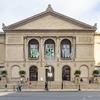Comments (5)

This painting is so beautiful! If nobody had told me it was a painting, I for sure would have assumed that it was a photo. First looking at this painting I thought it looked like a postcard from a trip. The mountains in the back at a lot of depth to the painting as well. Closer to the front you see some trees and some brush. That looks very detailed to me. Looking at it, it is like you can see leaves. There is some white on the leaves in the painting, showing possible light illuminating on the trees. The artist is able to paint very realistically as it looks like a photo. You can even see the mist from the waterfall. Frederic Edwin Church shows us a painting that looks like a photo.

This piece is definitely one of my favorites. The details of the mountains and waterfall give depth and texture. It looks like I could touch any of the items because of all the detail making the whole piece look completely realistic.

Out of all the artworks I've seen on this site, this one is by far one of my favorites. I love the technique that the painter uses to give this painting a sense of realism. I also appreciate how Church took great attention to detail with his waterfall and added the mist. These kinds of details help elevate a picture from good to great.

If no one told me this is a painting, I would think it is a perspective photo. There are vivid descriptions about everything in the painting, such as the person in the middle of the fall, and another woman is watching that guy, etc. The mountain behind is much more powerful and gives audiences a shock by its brilliant.














Wow! That is my first thought when I saw this painting, the colors are so warm and relaxing. I really like the greenery and nature all around in this painting and how the artist was able to make so much detail in every plant.